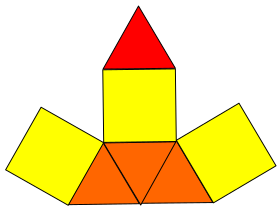| Elongated triangular pyramid | |
|---|---|
 | |
| Type | Johnson J6 – J7 – J8 |
| Faces | 4 triangles 3 squares |
| Edges | 12 |
| Vertices | 7 |
| Vertex configuration | 1(3) 3(3.4) 3(3.4) |
| Symmetry group | C3v, , (*33) |
| Rotation group | C3, , (33) |
| Dual polyhedron | self |
| Properties | convex |
| Net | |
 | |

In geometry, the elongated triangular pyramid is one of the Johnson solids (J7). As the name suggests, it can be constructed by elongating a tetrahedron by attaching a triangular prism to its base. Like any elongated pyramid, the resulting solid is topologically (but not geometrically) self-dual.
Construction
The elongated triangular pyramid is constructed from a triangular prism by attaching regular tetrahedron onto one of its bases, a process known as elongation. The tetrahedron covers an equilateral triangle, replacing it with three other equilateral triangles, so that the resulting polyhedron has four equilateral triangles and three squares as its faces. A convex polyhedron in which all of the faces are regular polygons is called the Johnson solid, and the elongated triangular pyramid is among them, enumerated as the seventh Johnson solid .
Properties
An elongated triangular pyramid with edge length has a height, by adding the height of a regular tetrahedron and a triangular prism: Its surface area can be calculated by adding the area of all eight equilateral triangles and three squares: and its volume can be calculated by slicing it into a regular tetrahedron and a prism, adding their volume up::
It has the three-dimensional symmetry group, the cyclic group of order 6. Its dihedral angle can be calculated by adding the angle of the tetrahedron and the triangular prism:
- the dihedral angle of a tetrahedron between two adjacent triangular faces is ;
- the dihedral angle of the triangular prism between the square to its bases is , and the dihedral angle between square-to-triangle, on the edge where tetrahedron and triangular prism are attached, is ;
- the dihedral angle of the triangular prism between two adjacent square faces is the internal angle of an equilateral triangle .
References
- Rajwade, A. R. (2001). Convex Polyhedra with Regularity Conditions and Hilbert's Third Problem. Texts and Readings in Mathematics. Hindustan Book Agency. p. 84–89. doi:10.1007/978-93-86279-06-4. ISBN 978-93-86279-06-4.
- ^ Berman, Martin (1971). "Regular-faced convex polyhedra". Journal of the Franklin Institute. 291 (5): 329–352. doi:10.1016/0016-0032(71)90071-8. MR 0290245.
- Uehara, Ryuhei (2020). Introduction to Computational Origami: The World of New Computational Geometry. Springer. p. 62. doi:10.1007/978-981-15-4470-5. ISBN 978-981-15-4470-5. S2CID 220150682.
- Sapiña, R. "Area and volume of the Johnson solid ". Problemas y Ecuaciones (in Spanish). ISSN 2659-9899. Retrieved 2020-09-09.
- Johnson, Norman W. (1966). "Convex polyhedra with regular faces". Canadian Journal of Mathematics. 18: 169–200. doi:10.4153/cjm-1966-021-8. MR 0185507. S2CID 122006114. Zbl 0132.14603.
 .
.
 has a height, by adding the height of a regular tetrahedron and a triangular prism:
has a height, by adding the height of a regular tetrahedron and a triangular prism:
 Its surface area can be calculated by adding the area of all eight equilateral triangles and three squares:
Its surface area can be calculated by adding the area of all eight equilateral triangles and three squares:
 and its volume can be calculated by slicing it into a regular tetrahedron and a prism, adding their volume up::
and its volume can be calculated by slicing it into a regular tetrahedron and a prism, adding their volume up::

 of order 6. Its
of order 6. Its  ;
; , and the dihedral angle between square-to-triangle, on the edge where tetrahedron and triangular prism are attached, is
, and the dihedral angle between square-to-triangle, on the edge where tetrahedron and triangular prism are attached, is  ;
; .
. "
"